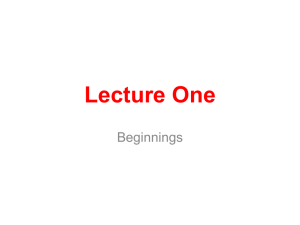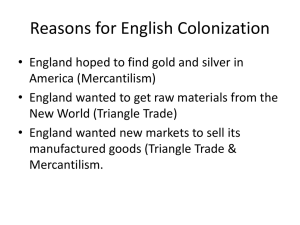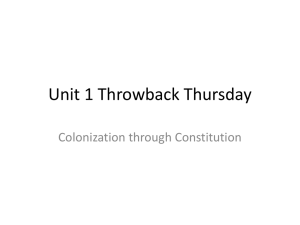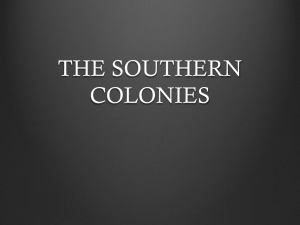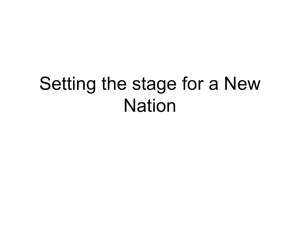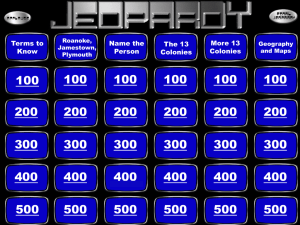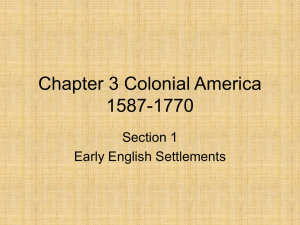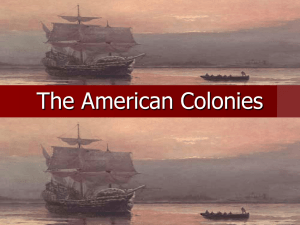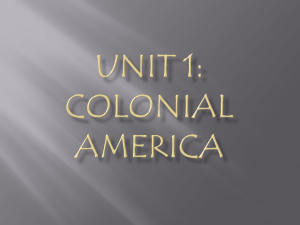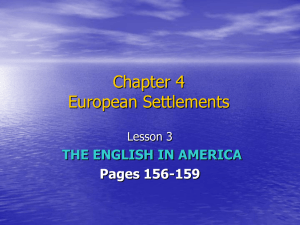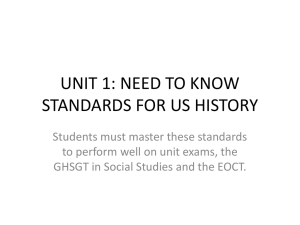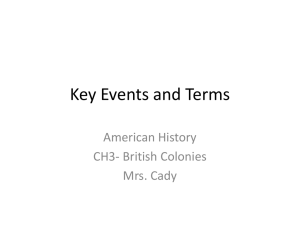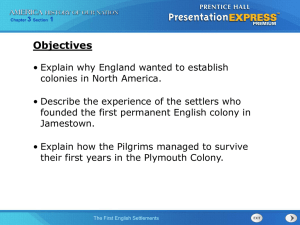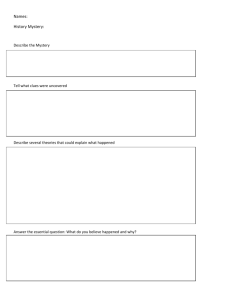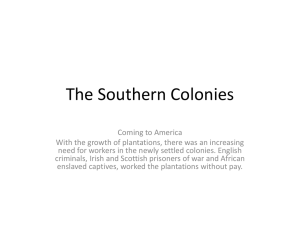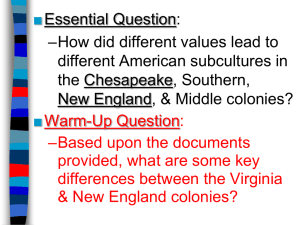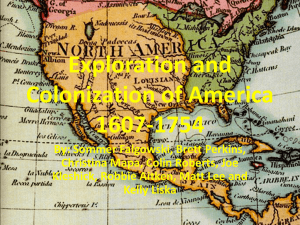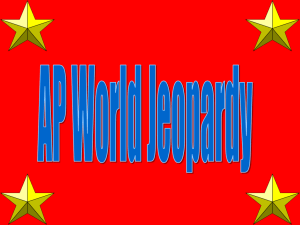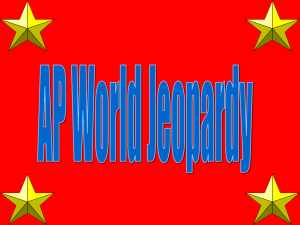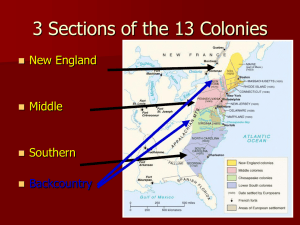04 GER Beginnings of..
advertisement
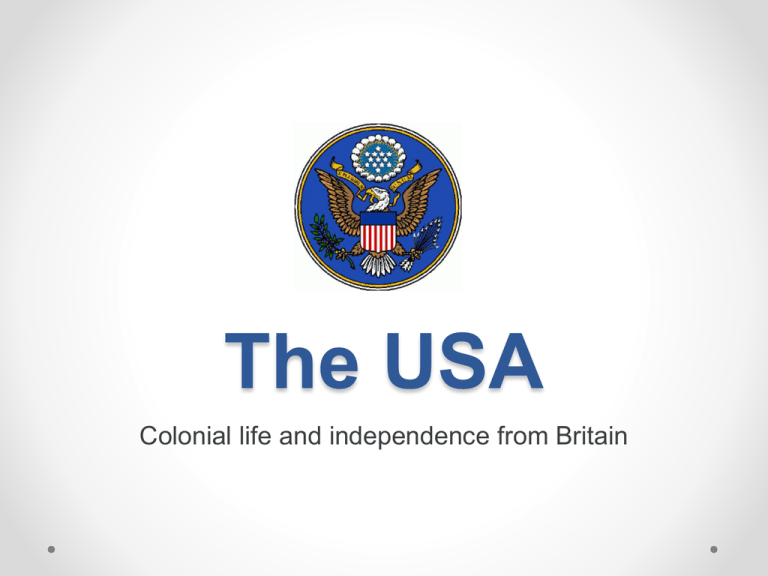
The USA Colonial life and independence from Britain How America influenced what we eat? “The Discovery” • 12 October 1492 – Christopher Columbus reaches the island he names San Salvador (Holy Savior) – he believed he was in India. • Inhabitants of the land became “Indians” (today they are usually called Native Americans). Why America is called America? • Italian explorer from Florence, Amerigo Vespucci described his journeys he made in the 1490s. • He suggested the existence of the new land to the east of Europe. The Beginnings of English Expansion in Northern America • Sir Walter Raleigh |ˈrɑːli| asked Queen Elizabeth to start a colony in the new world. • He reached Roanoke Island in 1584. • He named the entire region Virginia (from Virgin Queen = Elizabeth I). Roanoke Roanoke Island 1st settlement • Complete failure! • Most of the people died of hunger and attacks from Indians. The Second time • In 1587, Raleigh sent colonists a second time with wives and children. • John White was the colony’s governor. The Lost Colony • John White returned to England for supplies. • He returned to America in August 1590 to find no colonists on Roanoke Island. • On one of the trees they find a caption “CROATOAN” (it was the name of an island nearby as well as the name of the Native Americans living in the area. The Virginia Company • In 1606, King James I gives permission to the Virginia Company of London to try a colony. • On May 14, 1607, the settlers began building the first English permanent settlement on the James River in Virginia. • Jamestown was named after the King James I. Jamestown, Virginia Jamestown and Roanoke Island John Smith • In 1608, John Smith takes over leadership of the Jamestown colony. • Problems: hunger, disease, Indians. • January 1608, only 38 of the colonists remained alive. • Colony survives because: 1. 2. “No work, no eat” Bargaining for food with the Powhatan Indians. Pocahontas • Johns Smith fights with Powhatan Indians. • He is taken prisoner • He was saved by Pocahontas, a Powhatan Native American. Tobacco • Englishman John Rolfe in 1614 found a way to harvest tobacco. • He also married Pocahontas in 1614 and thus created peace with the Powhatan Native Americans for 8 years. Princess Pocahontas • Pocahontas, character of popular culture. • Brought to England, is baptized and dies young of smallpox a disease she did not know. JOHN ROLFE John ANDRolfe POCAHONTAS early 1850s, J. W. Glass Pocohantas Government and slavery • In 1619, a Dutch ship brings the first Africans to Jamestown – beginning of slavery. • In 1619, The Virginia Company of London sends 90 women to Jamestown as wives for the settlers (120 pounds of tobacco for a wife) After Jamestown • Jamestown colonists went to live in America because they wanted to get rich. They were sent there by businessmen (Virginia Company). • The second important group of colonists came to live in America because they wanted religious freedom. Religious conflicts in England • James I – conflict with the Puritans • Puritans decide to emigrate – first to Holland then to America. • Protestant dissenters: the Puritans – influenced by the teachings of John Calvin. • Puritans – because they wanted to keep the English Church (and English people) “pure”. • They did not recognize bishops, did not want colourful churches and sumptuous masses. 1620: The Pilgrim Fathers • 16 September 1620, Pilgrims leave England (Plymouth). • They are called Pilgrims – because they went there for religious purposes. The Mayflower The Pilgrim Fathers / Pilgrims land in America 9 November 1620 • They land in Massachusetts (land named after Native American people living there). • The first settlement is called Plymouth. • The land is called New England. New England: Cape Cod Difficult life of the early colonists • Problems similar to the problems of the previous settlers: hunger and diseases. • Half of the colonists (50 out of more than 100) die during the first winter. • The rest saved by native Americans who helped them and showed new food: corn, pumpkin, turkey. Thanksgiving • Every third Thursday in November. • Thanks to God for good harvest after one year in America, in November 1621. The Great Migration • Ten years later, in 1630, a second much larger group came to America, around 1000 people. • They established Boston. • Between 1630-1640, around 20 000 colonists came to America. • In 1661 – Plymouth Colony + Boston Colony = Massachusetts. Puritan Values • Puritans had a lasting influence on American culture. • Very idealistic: (“city on the hill”, “the New Jerusalem”). • But not very tolerant: duty of the government to make people obey God’s law, e.g. o going to the church compulsory o drinking, adultery and long hair in men punished American Utopia • America: model for other nations (doctrine of American exceptionalism). • Hard work and self moderation. • Education for all children. • Self-government. Formation of Other Colonies • 1626 – Colonists form Holland build New Amsterdam. In 1664 captured by the English and re-named New York. • 1634 – Maryland, a colony where Catholics could settle. • In 1681 William Penn – received a permission to start a colony in America: Pennsylvania. • 1691 – supporters of Charles II created North Carolina. • The last English colony was Georgia – settled in 1733. 13 English Colonies American flag Stars and Stripes Growth of the Colonies • Three major cities Philadelphia, New York and Boston. • In 1770 – Philadelphia, the biggest American city with the population of 28 000. Philadelphia English Colonies: 3 groups • New England colonies – mainly Puritans. • Middle Colonies (Pennsylvania) – greater religious tolerance and diversity; people not only from England but also Germany, Sweden and Holland. • Southern Colonies (Virginia, Carolinas, Georgia) – large plantations with slaves brought from Africa. Westward expansion • After 1733 – colonists start to expand to the west of the American continent looking for new land and new opportunities • The area where European settlement came to an end and the forest lands of the Amerindians began, was called the frontier (or later the Wild West). • “Frontier way of life”: independence, self-reliance, toughness. Conflicts with England • Costly war with Francenew taxes on imports of sugar, coffee, textiles, and other goods. • Need to feed the English soldiers. • Limits on the expansion to the West. • New taxes and regulations. • Colonists' fear: government too powerful: “No taxation without representation” Events leading up to the revolution 1. 2. 3. 4. The Proclamation of 1763 – England’s King George forbid colonist to settle west of the Appalachian Mountains. The Sugar Act of 1764 – tax on sugar from outside the British Empire. The Stamp Act of 1765 – required colonist to pay for tax stamps on newspapers, and various legal documents. Parliament abolished the Act in 1766. The Townshend Acts of 1767 placed a duty on imported goods including glass, lead, paint, and paper. Americans responded by not buying British goods. Boston Tea Party • On December 16, 1773, Samuel Adams led young men, disguised as Indians, on a raid of British ships docked in Boston’s harbor. • They dumped the cargoes of tea overboard. • This was later called the Boston Tea Party. The Intolerable Acts of 1774 • Britain’s response to the Boston Tea Party. • One act closed Boston’s harbor until the colonists paid for the destroyed tea. • Another took away nearly all power from Massachusetts’ legislature. • Control of the colony was given to the newly appointed British governor, General Thomas Gage. The First Continental Congress • September 5 – October 26, 1774 • Attended by representatives from all the colonies except Georgia. • They met in Carpenter’s Hall in Philadelphia to protest the Intolerable Acts. • Decided to stop trade with Britain unless the Acts were abolished. • They also advised colonists to prepare for war. • They agree to meet again in May 1775. The Forces • Britain had large numbers of well trained soldiers. Their uniforms included bright red jackets: “redcoats”. • The colonies did not have a central government, army, or navy. • Each colony did have a small citizen army called the militia: ordinary people. The American Revolution: 1775 • Fighting between British soldiers and the American Patriots began April 19,1775, at Lexington and Concorde, Massachusetts. • The war’s last major battle was at Yorktown, Virginia in September and October 1781. • Britain formally recognized America independence with the signing of the treaty of Paris on September 3, July 4, 1776 • Declaration of Independence • New Philosophy of human freedom. • Inspired by John Locke: natural rights of all humankind. • Government based on popular consent. • Benjamin Franklin: sent to Paris, makes a deal with France (Feb 8, 1778). Declaration of Independence • July 4, 1776 Declaration of Independence 4th of July Independence Day The Founding Fathers / Founders Benjamin Franklin John Hancock Thomas Jefferson George Washington James Madison The Statue of Liberty Declaration of Independence The Treaty of Paris • Signed September 3, 1783 • The Treaty recognized the independence of the new nation. • Established its borders – from the Atlantic Ocean to the Mississippi River; north to Canada; and south to Florida Constitutional Convention • May 1787 - Constitutional Convention in Philadelphia. • Washington – leader • March 1789 – Constitution • 1791 – 10 Amendments: Bill of Rights – basic personal freedoms. • 1789 – George Washington – the first president Beginnings • The most important document is the Constitution of the United States. • Finished in 1787 and officially adopted in 1790. • Before that the Articles of Confederation (1781). The Constitutional Convention in Philadelphia 55 delegates from 13 former colonies. Constitution: interesting facts • The constitution represents “the supreme law of the land”. o When state constitutions or laws are in conflict with the federal Constitution – these laws have no force. • The oldest in the world still in force (Polish “May” Constitution 1791). • Model for constitutions in other countries. • Only 27 amendments to date. Key principles • The separation of powers. • Three branches: o Legislative o Executive o Judicial • Each one having powers over the other. • System of checks and balances (system hamulców i równowagi) . The Bill of Rights (10 amendments) 1. 2. 3. 4. 5. Freedom of religion. Freedom to possess guns. No searching without warrant. No private property taken without compensation. Right to a speedy and public trial, by an impartial jury.

